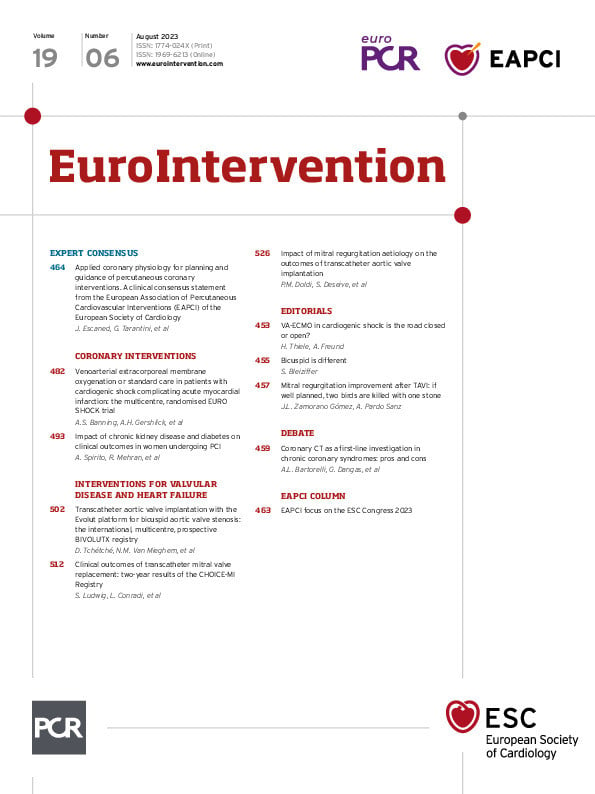Not infrequently, mitral regurgitation (MR) coexists with aortic stenosis (AS). It is also well known from papers and clinical practice that in some patients, pre-existing mitral regurgitation improves after transcatheter aortic valve implantation (TAVI) for the treatment of AS. In this issue of EuroInvention, the article by Doldi and colleagues, “Impact of mitral regurgitation aetiology on the outcomes of transcatheter aortic valve implantation”1, analyses outcomes and changes in mitral regurgitation (MR) severity, with different aetiologies, after TAVI. For this study, all patients showing MR ≥2 were categorised, depending on the MR aetiology into three groups: atrial functional mitral regurgitation (aFMR), ventricular functional mitral regurgitation (vFMR) and primary mitral regurgitation (PMR) following TAVI.
The patient group with aFMR showed the highest rates of MR improvement, and PMR was associated with the lowest rate of MR improvement at follow-up. The rate of MR improvement was 80.2% in aFMR versus 40.8% in PMR (p<0.001).
This makes sense, since in PMR, the primary defect that caused the MR (mitral valve prolapse, calcificationâ¦) is still present following TAVI. Of note, in such patients the persistence of MR after TAVI is associated with the lowest survival rates and least symptomatic improvement. Therefore, for patients with coexisting AS and PMR, special attention and a deep Heart Team discussion before intervention are necessary.
More difficult to explain is the difference between aFMR and vFMR. The rate of MR improvement was 80.2% in aFMR patients versus 69.4% in vFMR patients (p=0.03). It is already known that the left ventricular ejection fraction improves after TAVI and that it has a positive effect on the prognosis2. One could think that in patients with vFMR, the improvement could be partially explained by a reduction in MR.
So, the question is, why does aFMR improve more than vFMR? This reminds me of the debate about the controversial results of the MITRA-FR3 and COAPT4 trials. The patients with better results after percutaneous treatment of MR were those with more severe MR and less advanced left ventricular disease. In the current study by Doldi et al1, patients with functional MR and less ventricular disease corresponded to the group with aFMR. On the contrary, in the group with vFMR, MR was more a consequence of the disease of the left ventricle, and it was “proportional” to left ventricular dysfunction/dilatation. These patients would have been more “MITRA-FR-like”3. Therefore, in this group, MR was not expected to be greatly reduced after TAVI, nor would it be expected to improve much after edge-to-edge percutaneous treatment3. New York Heart Association Functional Class IV was more prevalent in the group with vFMR, which is in line with the idea of a more advanced ventricular disease.
The management of MR in patients undergoing TAVI should be determined according to the aetiology of the MR, as the response to the procedure is different in each group. The elegant study by Doldi et al1 simply reflects a proof-of-concept and explains the differences seen in previously reported trials. A careful examination of the mitral valve is required before and after TAVI. The aetiology of the MR can predict the response and outcomes after TAVI. Regarding PMR, it doesn´t improve a lot after TAVI. For these patients, a dual-valve intervention (percutaneous or surgical depending on the case) might be beneficial, as a sufficient MR reduction after TAVI is probably not expected. In patients with functional MR, a “watchful waiting” strategy, as suggested by current guidelines5 seems preferable, especially in aFMR patients, as MR severity might improve after the procedure. Before deciding, look at both valves, look at the aetiology, look at the ventricle, and look at the patient. Then decide, the winner takes it all. If well planned and selected, you can kill two birds with one stone.
Conflict of interest statement
The authors have no conflicts of interest to declare.

